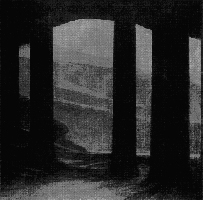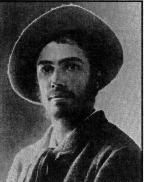LIGHTING DESIGN Part 2
Light Designer's Processes
The lighting designer's process is similar to that of the scene and
costume designers, but most of her work begins later in the production
process. A lighting designer can not make concrete decisions about
her design until she knows the set design and director's basic staging.
1. Script analysis. The lighting designer looks for
basic plot, characterization, and thematic choices, then more specifically
for indications of time, place, mood, and style. If there
are many short scenes or scenes that take place in more than one location
at a time, the lighting design will be important in establishing a style
of movement in time and space for the production. The following example
shows a highly theatrical, as opposed to motivational or illusionistic,
use of lights.
2. Production meetings. The lighting designer's ideas must fit within the director's overall concept and support the scene and costume designers' work. Although her busiest time falls later than the other two designers, she is part of the design discussions from the beginning to be sure that all visual elements will be well coordinated.
3. Once the lighting designer has seen the renderings for the set and costumes, received a groundplan and attended a rehearsal to see how the actors use the stage space, the lighting designer can firm up her ideas and concepts for the use of light. She may make a rendering to demonstrate the look of light on the set, or she may use a light lab or light a model to see how the lights will look in three dimensional space and in movement.
4. The lighting designer communicates her ideas to the light crew,
who will actually hang the lights, by creating a lightplot.
The lightplot, like the groundplan, is a bird's eye view of the stage and
shows the locations of the major pieces of scenery. Unlike the groundplan,
it breaks the stage into areas which will be lit together, shows at least
the part of the house over which lighting instruments are to be hung, and
shows the exact position where each lighting instrument is to be placed.
The designer uses templates to draft each distinct kind of instrument,
and she includes a key describing what color (and pattern) should
be placed in each instrument and how the instruments should be cabled
and patched into the dimmers. When lights are patched together,
a single dimmer can control multiple instruments.
5. Light hang and focus: The lighting designer in
professional theatre does not hang instruments, just as the professional
scene designer does not build scenery or the costumer construct the costumes.
After all instruments are hung and cabled,
they are focused one by one, which means aimed at the appropriate area
of the stage; and, if they are spotlights, lights are focused and shaped,
or shuttered. Again, the professional lighting designer may
not be present for the light focus.
6. Set cues: The lighting designer meets with the director and stage manager before technical rehearsals begin; they determine when, where, and how quickly each light cue, or change in any or all lights, should occur. The stage manager will be responsible for calling cues to the light board operator during technical rehearsals and performances.
7. During technical rehearsals, the lighting designer, director, and other designers see how the results of their collaboration fit together for the first time. Any of the designers' work or the director's staging may be adjusted during "tech" for a greater coherence of the entire production.
Historical Conventions of Light Design
Before the Renaissance, theatre was typically performed outdooors,
weather permitting, with light provided at the whim of Mother Nature.
When productions began to be mounted indoors at the Renaissance, candlelight
was used. Candles had many drawbacks: it took enormous numbers
of candles which had to be replaced as they burnt down, candles dripped
and smelled badly, and the fire hazard was extremely serious.
The next step from candles was oil lamps. Oil lamps eliminated the problem of replacing candles and of dripping wax and reduced the fire hazard because the flame was now enclosed. However, they were still dangerous, smelled badly, produced a great deal of smoke, and required individual lighting and extinguishing. The first experiments in coloring light were performed in the 18th century: light, colored fabric or colored water was placed around the lamp.
In the early 1800's, gas lines were invented and installed quickly through major cities. One of the first theatres anywhere to use gas lighting was Philadelphia's Chestnut Street theatre in 1816. Gas again reduced the risk of fire because the entire gas supply could be extinguished at a central point. But gas lights were still flames, and the gas lines made explosions possible. Artists continued to experiment with color in light. Gas lighting also enabled the gas table, the earliest version of a dimmer.
Early in the nineteenth century the first spotlights were invented, the limelight and carbon arc. The limelight was invented in 1816 and pioneered in theatres in the 1830's. It uses gas plus cylcinders of oxygen and hydrogen to heat a column of lime until it gives off light. It was so bright that at first it was used mostly to represent a sun or moon on the background. The carbon arc began to be used widely in the theatre in the 1840's; it involved giving a positive charge to one stick of carbon and a negative charge to another and then bringing the carbons close together to produce light. In the 1860's the carbon arc was placed inside a casing with a lens to create the cone shape of the spotlight. Carbon arcs are very bright, but inconsistent in intensity and noisy.
It was Thomas Edison's patenting of the incandescent light bulb
in 1879 that led to real control over stage lights and therefore the profession
of lighting designer. Adolphe Appia and Edward Gordon Craig
were the earliest designers to champion light as a major design element
in lighting their simplified, three dimensional, symbolic sets. Appia in particular
Appia in particular wrote of designing the light so that it shifted constantly with the mood
of the scene, evoking response in the audience the same way that music
constantly changes producing subtle variations in tone and mood.
wrote of designing the light so that it shifted constantly with the mood
of the scene, evoking response in the audience the same way that music
constantly changes producing subtle variations in tone and mood.
In the twentieth century, lighting has become easier to control and
has even more possibilities through new technological inventions.
Many designers have used projections
as an integral part of scenery, whether as abstract commentary on the action
or setting or to evoke a literal setting. Projections may also be
still or moving images, and today they may be shot with a camera or created
by computers.
To Sound Design
Part 1
BACK TO BLOOD'S COURSE MATERIAL
HOME PAGE